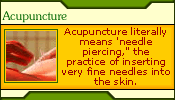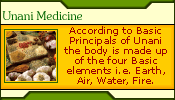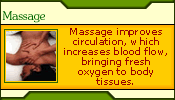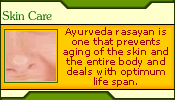|
It refers to the treatment of the ailment i.e. Aushadhi (medicine),
Anna (diet) and Conduct, which is helps to cure the disease. The
opposite of this is unupshaya. Treatments are classified as follows:
(1) Hetuviparit (anti factor)
This refers to the treatment that is opposite to the factor, which
causes the disease and can be classified in three sub categories,
namely:
Hetuviparit aushadhi
They are the medicines that control the ailment.
Example: In Kaphaj jwar dried ginger is the medicine as
it corrects the imbalance of kapha dosha in the body, which cures
kaphaj jwar. Here medicine i.e. ginger is opposite of the factor
i.e. kapha dosha.
Hetuviparit anna
The diet opposite to the disease-causing factor is called hetuviparit
anan.
Example: To have chicken soup as diet in shramaj jwar (fever
due to tablets). That is caused due to over exertion leads to imbalance
of vat dosha and chicken soup balances the vat dosha in the body
and removes tiredness.
Hetuviparit vihara
This refers to the type of conduct that controls the disease-causing
factor.
Example: Sleeping in day- time disturbs the kapha dosha
in the body which leads to kapha (cold and cough), thus the treatment
for this is to sleep at night, which controls the disturbed kapha
dosha, and ultimately cures the disease.
(2) Vyadhiviparit (anti disease)
This refers to specific means to cure certain disease.
Vyadhiviparit Aushadhi
These are the medicines specifically for a certain disease.
Example: Kutaj (Holarrhena anti dysenteric) is the specific
medicine for diarrhea.
Vyadhiviparit Anna
It refers to diet specific to the disease.
Example: In diarrhea pulse of masoor is the specific diet.
Vyadhiviparit Vihar
It refers to the conduct specific to the disease.
Example: In Udhavart (a kind of disease in which excreta
comes out through mouth) pravahan (make effort by abdomen to defecation)
is the specific conduct (vihar).
(3) Hetuvyadhiviparit (anti factor &
anti disease)
This refers to the treatment, which is specific to the disease and
yet is an anti factor.
Hetuvyadhiviparit Aushadhi
It is the medicine that controls the positive factor and ci\ures
the ailment.
Example: The medicine dashmool is specific for vatajshotha.
Here dashmool controls the disturbed vatadosha in the body. It is
also specific to control the shotha (edema).
Hetuvyadhiviparit Anna
It is the diet specific to the disturbed doshas and is specific
to the disease.
Example: Takra (buttermilk) is the specific diet for vatajgrahani
(a type of indigestion). Here takra controls the disturbed vatadosha
in the body. It also improves digestion of the body.
Hetuvyadhiviparit Vihar
This refers to the conduct that is specific to control the disturbed
dosha and is specific to for controlling the ailment.
Example: Tandra developed due to excessive use of fatty
things and day time sleep. Rukshavihar (conduct which reduces fat,
such as running walking etc). Exercise like running walking etc
controls the disturbed kapha dosha in the body.
(4) Hetuviparitarthkari (anti causative
subjective)
This refers to the factors that initially might be supporting the
causative factor but helps in curing the ailment at the end.
Aushadhi (medicine)
Example: The suppuration of boil is caused by disturbed
pittadosha. When upanha (type of poultice) is used for the treatment
of boil it enhance the process of suppuration of boil by exciting
pittdosha. Here the medication seems to enhancing the causative
factor i.e. pitta dosha. As after suppuration of boil puss is drained
which support healing. This way upnha, which seems to be a pro causative
factor ultimately cures the boil.
Anna (diet)
To take vidahi anna (the diet which imbalance the pitta dosha )
as diet in boil. Here also the vidahi anna excites the pitta dosha,
which enhance the suppuration of boil. After suppuration puss is
drained out from the boil, which supports healing.
Vihar (conduct)
According to ayurveda the fear disturbs vatdosha to treat vatik
unmad (a form of psychotic disorder) patient is feared and angry.
Here anger and fear excite the vata dosha, but the action of scolding
and fear control the patient and ultimately he get cured.
(5) Vyadhiviparitarthkari (anti disease
subjective)
This refers to the means, which are supposed to be exaggerating
the disease, but it ultimately it cures it.
Aushadhi (medicine)
Example: Madan phala (Randia dumetorum) exaggerate vamana
(vomiting). In the treatment of kaphaj vaman it helps to remove
unwanted cough by exaggerating vaman (vomiting).
Anna (diet)
Example: Milk is a mild laxative which may promotes diarrhea.
In dysentery milk helps to remove mucous from the gastro intestinal
tract by promoting evacuation. Thus to take milk in dysentery helps
in its cure.
Vihar (conduct)
Example: To promote vomiting (vaman) in the disease vaman
(vomiting) helps to remove polluted cough from the body but it relives
patient and accurate it.
(6) Hetu- Vyadhiviparitarthkari (anti
factor & anti disease subjective)
This type of treatment seems to be anti causative factor and disease
promoting but the ultimately it cures the disease.
Aushadhi (medicine)
Example: According to ayurveda Agru (type of herb) promotes
warmth in the skin. Agru is applied on the burns and scalds as its
treatment. Inspite of its warm nature it enhances the blood flow
to the effected part, which helps in healing.
Anna (diet)
Example: In a chronic alcoholic patient to avoid withdrawal
syndrome, alcohol in small amount is provided.
Vihar (conduct)
Example: According to ayurveda frozen shoulder develops
due to the disturbance in equilibrium of vata dosha. As cold water
and the conduct of swimming both may disturb vata dosha. This conduct
seems to be disease promoting but during swimming the heat produced
by the action get trapped in the effected area (frozen shoulder).
This warmth corrects the disturbed equilibrium of vata dosha and
ultimately the disease is cured.
|









